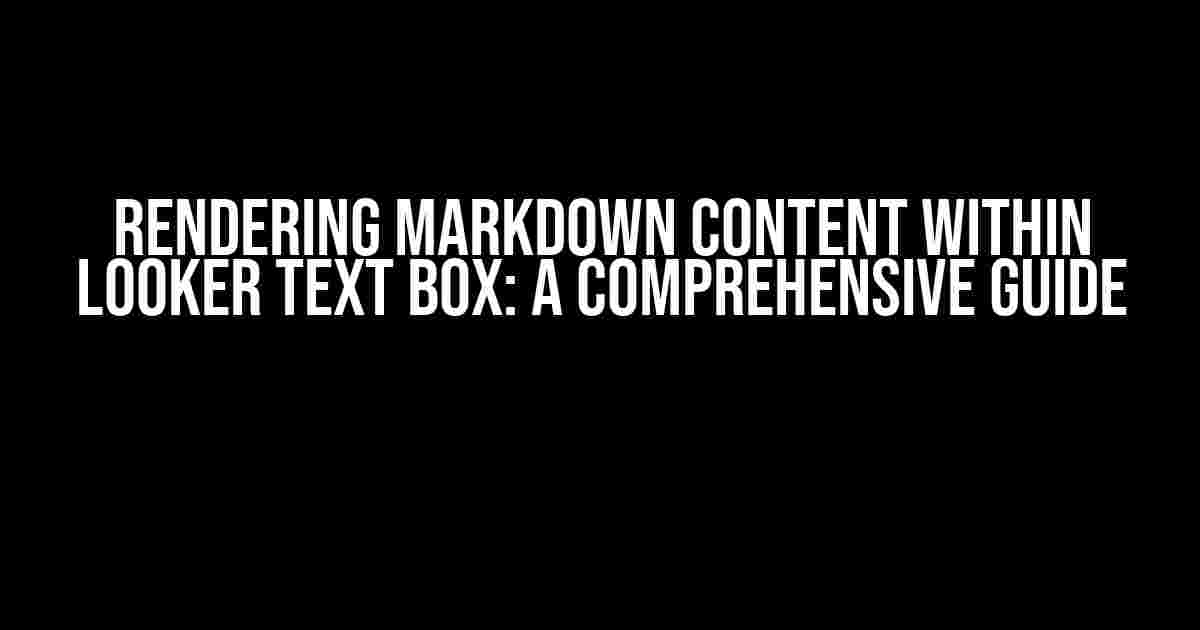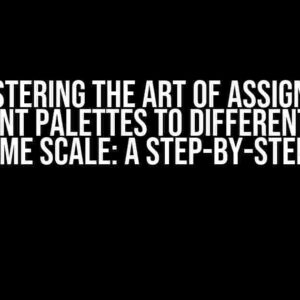Are you tired of formatting your text content within Looker using plain old HTML? Do you want to add some flair to your visuals and make them more engaging? Look no further! In this article, we’ll dive into the world of Markdown and show you how to render Markdown content within a Looker text box. By the end of this tutorial, you’ll be a Markdown master, ready to take your Looker visuals to the next level.
What is Markdown?
Markdown is a lightweight markup language that allows you to create formatted text using plain text syntax. It’s easy to read and write, making it a popular choice for bloggers, writers, and developers alike. With Markdown, you can create headings, italicize text, add links, and more, all without the need for HTML coding.
Why Use Markdown in Looker?
So, why would you want to use Markdown in Looker? Here are just a few reasons:
- Easier to read and write: Markdown is much more readable than HTML, making it perfect for creating visually appealing text content within Looker.
- Faster formatting: With Markdown, you can format your text quickly and easily, without the need for tedious HTML coding.
- Consistency across platforms: Markdown is supported by many platforms, including Looker, GitHub, and Stack Overflow, making it a great choice for sharing content across different tools.
Getting Started with Markdown in Looker
Ready to start rendering Markdown content within your Looker text box? Here’s what you need to do:
- Enable Markdown rendering in Looker: The first step is to enable Markdown rendering in Looker. To do this, head to your Looker instance and navigate to the “Admin” section. From there, click on “Settings” and scroll down to the “Formatting” section. Make sure the “Render Markdown” toggle is switched to “On”.
- Create a new text box in Looker: Next, create a new text box in Looker by clicking on the “Add a tile” button and selecting “Text” from the dropdown menu. Give your text box a name, and enter some Markdown content into the text editor.
Markdown Basics
Now that you’ve enabled Markdown rendering and created a new text box, it’s time to learn some Markdown basics. Here are a few essential commands to get you started:
| Markdown Syntax | Result |
|---|---|
| `**Bold text**` | Bold text |
| `*Italic text*` | Italic text |
| `[Link text](https://www.example.com)` | Link text |
| `# Heading 1` | |
| `## Heading 2` |
Heading 2 |
| `### Heading 3` |
Heading 3 |
Advanced Markdown Techniques
Now that you’ve mastered the basics, it’s time to move on to some more advanced Markdown techniques. Here are a few tips and tricks to help you take your Markdown skills to the next level:
Tables
Creating tables in Markdown is a breeze. Simply use the `|` character to separate columns, and `—` to separate rows. Here’s an example:
| Column 1 | Column 2 | Column 3 | |----------|----------|----------| | Cell 1 | Cell 2 | Cell 3 | |----------|----------|----------| | Cell 4 | Cell 5 | Cell 6 |
Code Blocks
Need to include some code in your Markdown content? Use triple backticks (““) to create a code block. Here’s an example:
``` This is a code block ```
lists
Markdown supports ordered and unordered lists. Use numbers or asterisks to create lists. Here’s an example:
* Item 1 * Item 2 * Item 3 1. Item 1 2. Item 2 3. Item 3
Troubleshooting Common Issues
Encountered an issue while rendering Markdown content in Looker? Don’t worry, we’ve got you covered. Here are some common issues and their solutions:
Markdown not rendering
If your Markdown content isn’t rendering correctly, make sure that:
- You’ve enabled Markdown rendering in Looker (see step 1 above)
- You’re using the correct Markdown syntax
- You’ve saved your text box and refreshed the page
HTML entities not supported
If you’re trying to use HTML entities (such as ` ` or `—`) in your Markdown content, you may encounter issues. Instead, use Markdown syntax to achieve the same result. For example, use ` ` to insert a horizontal tab.
Conclusion
And that’s it! With these instructions, you should now be able to render Markdown content within your Looker text box. Remember to practice your Markdown skills, experiment with different syntax, and don’t be afraid to try new things. Happy Markdown-ing!
Additional Resources
Want to learn more about Markdown and its capabilities? Check out these additional resources:
We hope this article has been helpful in guiding you through the process of rendering Markdown content within your Looker text box. Happy Looker-ing!
Frequently Asked Question
Get the lowdown on rendering markdown content within Looker text boxes!
Can I use markdown in Looker text boxes?
Absolutely! Looker supports a range of markdown syntax, including headers, bold and italic text, lists, and more. You can use markdown to format your text boxes and make your data storytelling shine.
How do I enable markdown rendering in Looker?
Easy peasy! To enable markdown rendering, simply toggle the “Render as Markdown” switch in the text box settings. This will enable Looker to interpret your markdown syntax and render it beautifully.
What markdown syntax is supported in Looker?
Looker supports a range of markdown syntax, including headers (##), bold text (**), italic text (*), lists (-, +, or *), code blocks (““), and more. You can check out the full list of supported syntax in Looker’s documentation.
Can I use HTML instead of markdown in Looker text boxes?
Yes, you can! Looker also supports HTML syntax in text boxes. However, keep in mind that markdown is generally easier to read and write, especially for non-technical users. If you’re comfortable with HTML, go for it – but markdown is a great option too!
Are there any limitations to using markdown in Looker text boxes?
A few! While Looker supports a range of markdown syntax, there are some limitations. For example, Looker doesn’t support inline HTML or custom CSS, and some markdown features (like tables) might not work as expected. Be sure to check out Looker’s documentation for the full scoop on markdown limitations.



